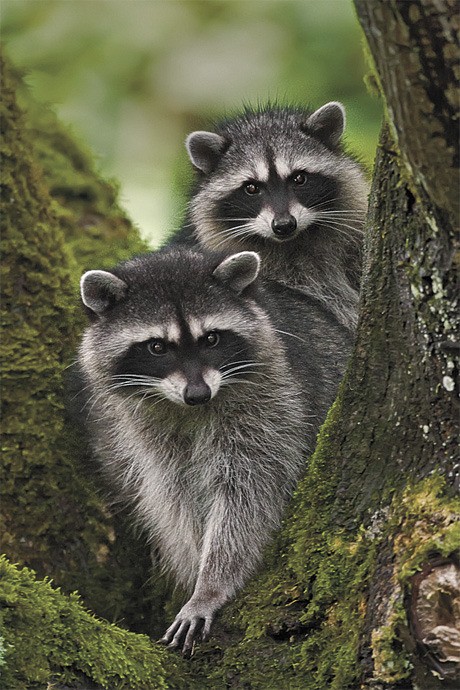The Andrews family didn’t used to be all that concerned about seeing wildlife around their home in a rural neighborhood on East Mercer Way, but that all changed a few weeks ago when their 15-year-old lab died of injuries that were probably inflicted by a raccoon.
Now, they said, they are worried about their 14-month-old baby, and they keep squirt guns on hand to prevent the animals from getting too close.
Raccoons, a medium-sized predator native to North America, have become well-adapted to living in metropolitan areas, according to officials from the Washington Department of Fish and Wildlife, and they can get aggressive and spread diseases if they get too comfortable around people’s homes.
“Raccoons are common; we’re not getting rid of them, so we want to keep them wild,” said Chris Anderson, a wildlife biologist with the Department of Fish and Wildlife. “Generally, as long as they are kept out of homes and the vicinity and they aren’t cornered, they just go about their business.”
Problems tend to arise, Anderson said, when people feed raccoons or leave food out by accident because this leads the animals to lose their fear of humans and often to become more aggressive around people and pets.
Providing inviting places for raccoons to nest with their young, such as uncapped chimneys and accessible space under porches or in attics, can lead to similar problems, he said.
Robert Andrews, of Mercer Island, said he started noticing more raccoons in his neighborhood a few years ago when a neighbor began leaving cat food outside.
“For years, we let our dogs out and it hasn’t been a problem,” Andrews said. “But over the past few years, we’ve started to see raccoons on a more frequent basis and we’ve started to see them even in broad daylight.”
He said so far one of his dogs has died and another had to have stitches from injuries that the veterinarian said were probably inflicted by raccoons, though nobody saw the confrontations take place.
“We got a call on Friday morning from a neighbor saying, your dog is in our driveway and she’s bleeding, and it looks like she’s dying,” said Andrews.
He said his wife put the dog in the car and rushed it to the vet, but it died later of its injuries.
“She was 15 years old and kind of deaf and very timid,” Andrews said. “She’s afraid of cats, so we didn’t think she would confront raccoons.”
He said they only allow their dogs out of the house on leashes now and they use squirt guns to deter raccoons that come close, but he regretted not being able to let his pets roam freely like they did before.
He was frustrated that food left out by neighbors was bringing raccoons to his home as well, he said.
“It would be nice if there was some sort of law that says you shouldn’t feed raccoons,” Andrews said. “And if there’s not, maybe there should be.”
In 2009, a bill was introduced to the Washington state Legislature that would have made it illegal to feed raccoons and other wind animals, including deer, bears and cougars. At the end of the 2010 legislative session, the bill, number HB 1885, had passed the house but still had not become law, according to the Legislature’s Web site.
In King County, it is illegal to allow materials to accumulate on your property that could provide a food source for rodents, according to King County Board of Health Code Title 8, though these regulations do not mention feeding raccoons.
For now, Anderson said, people concerned about raccoons near their homes should discuss keeping pet food indoors with their neighbors, buy trash cans that close securely and consider creating raccoon-friendly areas away from houses, for instance, by leaving stumps for them to nest in.
Raccoons are most active at night, he said, so keeping pets indoors overnight and only feeding them inside or during the day are also good ideas.
If you are confronted by an aggressive raccoon, Anderson said you should make yourself look as large as possible, back away from the animal and pick up small pets. You can also deter raccoons without hurting them by throwing water or water mixed with vinegar at them, he said.
He said there tend to be more aggressive raccoons in urban areas than elsewhere because they often lose their fear of people. If you have a problem animal that won’t respond to deterrents, you can call Fish and Wildlife.
Raccoons in close quarters with people can also cause problems because they can spread canine distemper, a disease that also affects dogs, and their droppings and urine may contain parasites that can cause serious illness in humans, said Sharon Hopkins, King County Public Health Veterinarian.
In some other parts of the United States, raccoons also carry rabies, Hopkins said, though there has never been a documented case of a raccoon with rabies in Washington.
According to the Department of Fish and Wildlife, you should see a doctor or a vet if a person or pet is bitten by a raccoon, avoid contact with raccoon feces and make sure children wash their hands after playing outside in areas where raccoons could have been.
Raccoon tips
For more information on raccoons and how to discourage them from living near your home, go to: http://wdfw.wa.gov/living/raccoons.html#conflicts.


